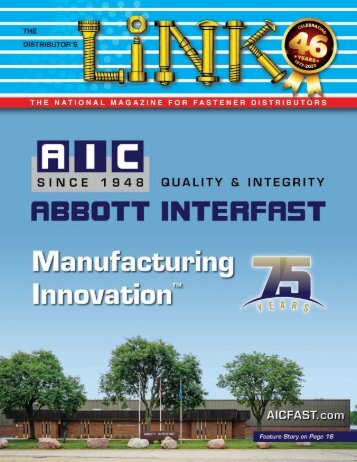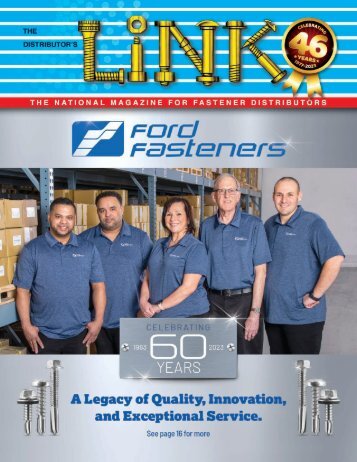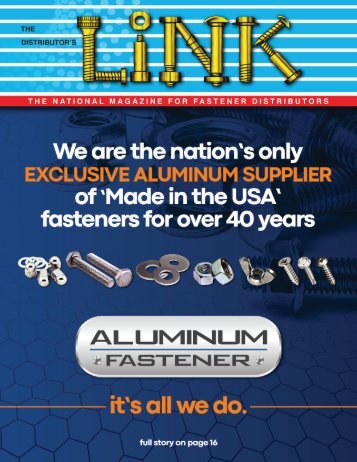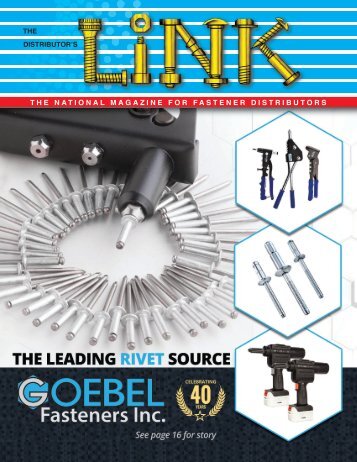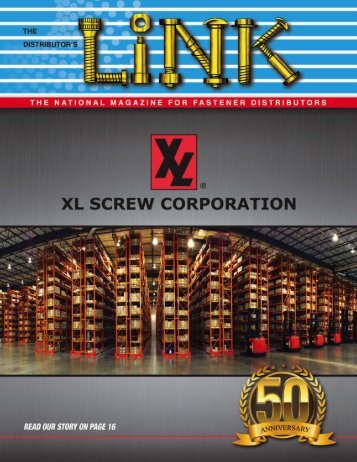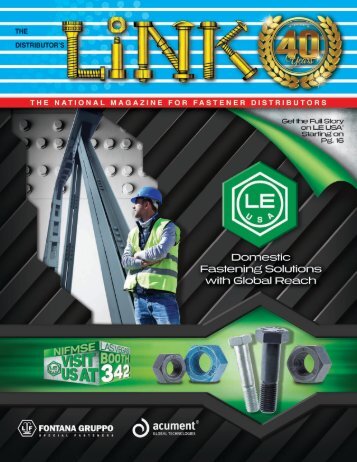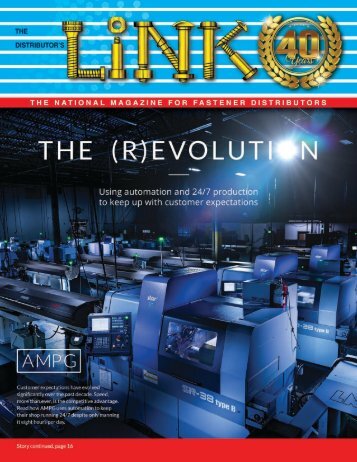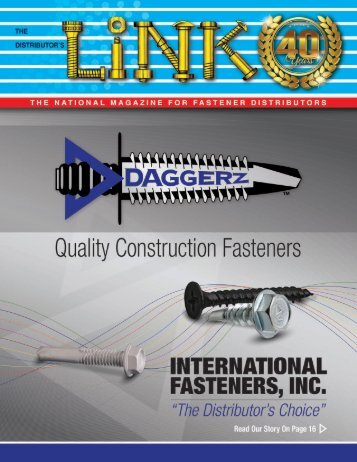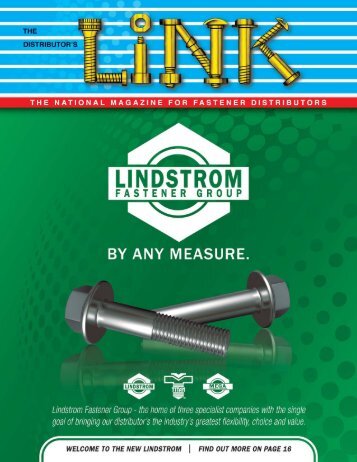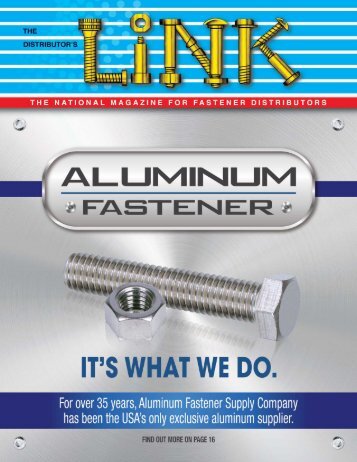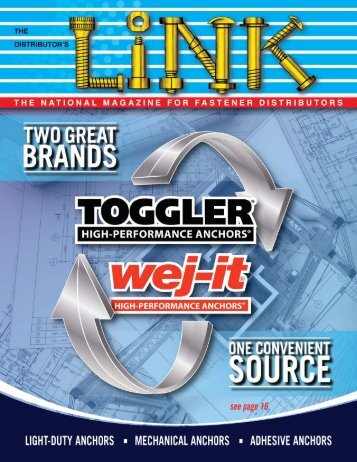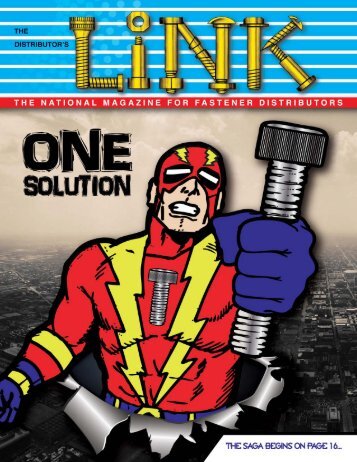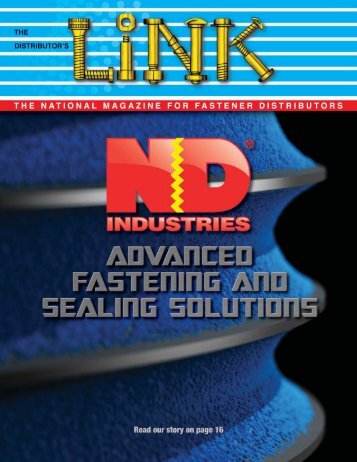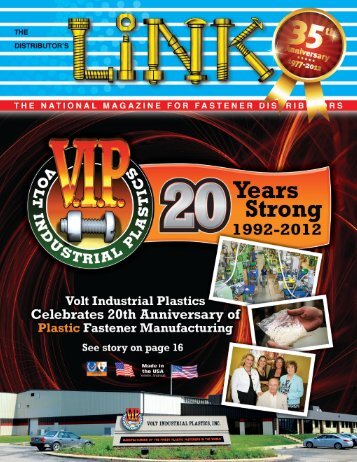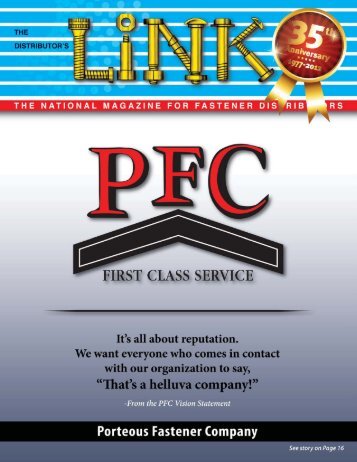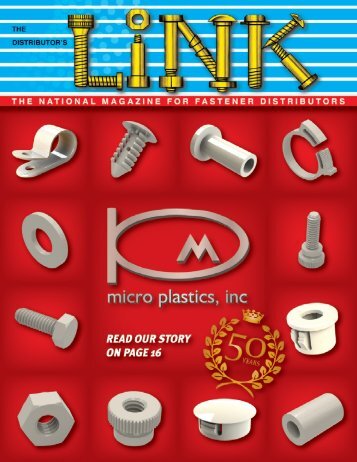SPRING 2019
- Text
- Wifi
- Manufacturing
- Continued
- Products
- Fatigue
- Industrial
- Association
- Distributors
- Fasteners
- Fastener
58 THE DISTRIBUTOR’S
58 THE DISTRIBUTOR’S LINK STEEL KING INDUSTRIES INC. 2700 Chamber Street, Stevens Point, WI 54481 TEL 1-800-826-0203 EMAIL info@steelking.com WEB www.steelking.com PALLET FLOW RACK CAN BE A WAREHOUSE MANAGER’S BEST FRIEND by Ryan Wachsmuth When properly designed to meet the specific inventory and storage requirements, pallet flow racks maximize storage space and improve shipping logistics. Any warehouse or distribution center with limited floor space that needs high density storage or automatic rotation of inventory on a first-in, first-out (FIFO) basis can benefit by implementing pallet flow storage racks. However, achieving the full performance capabilities of this type of rack system requires careful planning and implementation. When this is done properly, pallet flow systems can be the warehouse manager’s best friend; without it, the system may underperform expectations. Simply defined, this type of racking system is designed so that when the pallet in front is removed by a forklift, the pallets behind gently “flow” forward to replace it. Inclined tracks, rollers, and brakes – with an assist from gravity – are used to accomplish this task. New inventory is then loaded at the back end of the rack, facilitating FIFO product rotation, which is particularly valuable for items with expiration dates. In this type of “dynamic” racking approach, goods can be stored 3, 10, even 20 pallets deep and on multiple levels. This eliminates the need for wide aisles between every row of traditional “static” rack required for forklift access and maneuverability. By storing more palletized goods in less space, facility managers can dramatically increase the amount of inventory in a specific warehouse footprint or, on the flip side, reduce the amount of space required for new warehouse construction. Compared to traditional fixed racking, a high density INCLINED TRACKS, ROLLERS, AND BRAKES – WITH AN ASSIST FROM GRAVITY – ARE USED IN THE STEEL KING RACKING DESIGN pallet flow system can essentially cut the required square footage for a warehouse in half. The savings can be significant in terms of reduced property and building costs. There are substantial logistical benefits to using a dynamic rack system as well. Pallet flow rack can drastically reduce the labor required to pick pallets, because a forklift is only needed for initial loading of the pallets as well as final unloading. With static racks, forklifts must travel further down aisles and often must spend time rearranging inventory to access the correct items. When a large number of pallets with a single product SKU are routinely loaded into trucks, locating the pallet flow rack near the loading dock can also minimize the distance that forklifts travel to as little as 20 feet each way, which speeds material handling. Even pallets with varied SKUs that are being shipped to the same location can be located near each other to further speed truck loading. BUSINESS FOCUS ARTICLE CONTINUED ON PAGE 130
THE DISTRIBUTOR’S LINK 59
- Page 6 and 7:
in the Spring 2019 issue of 6 DISTR
- Page 8: 6 THE DISTRIBUTOR’S LINK Stamping
- Page 12: 10 THE DISTRIBUTOR’S LINK Joe Dys
- Page 16: 14 THE DISTRIBUTOR’S LINK Laurenc
- Page 19 and 20: After the trade show I researched w
- Page 22: WIFI Wearables was introduced in 20
- Page 26: 24 THE DISTRIBUTOR’S LINK COMPUTE
- Page 30: 28 THE DISTRIBUTOR’S LINK Jim Tru
- Page 34 and 35: 32 THE DISTRIBUTOR’S LINK Bruno M
- Page 36: 34 THE DISTRIBUTOR’S LINK FASTENE
- Page 40: 38 THE DISTRIBUTOR’S LINK FASCOMP
- Page 44: 42 THE DISTRIBUTOR’S LINK Advance
- Page 47 and 48: THE DISTRIBUTOR’S LINK 45
- Page 50: 48 THE DISTRIBUTOR’S LINK MID-WES
- Page 53 and 54: THE DISTRIBUTOR’S LINK 51 Endries
- Page 55 and 56: THE DISTRIBUTOR’S LINK 53
- Page 58: 56 THE DISTRIBUTOR’S LINK BIG RED
- Page 64: 62 THE DISTRIBUTOR’S LINK Roman B
- Page 68: 66 THE DISTRIBUTOR’S LINK INTERNA
- Page 71 and 72: THE DISTRIBUTOR’S LINK 69
- Page 73 and 74: ZAGO MANUFACTURING INC. DEALING WIT
- Page 76 and 77: 74 THE DISTRIBUTOR’S LINK COMPONE
- Page 78 and 79: 76 THE DISTRIBUTOR’S LINK SWD Inc
- Page 80 and 81: 78 THE DISTRIBUTOR’S LINK John R.
- Page 82: 80 THE DISTRIBUTOR’S LINK SPIROL
- Page 85 and 86: INTERNATIONAL FASTENERS, INC. SPRIN
- Page 88: 86 THE DISTRIBUTOR’S LINK SOUTHWE
- Page 91 and 92: THE DISTRIBUTOR’S LINK 89 NEFDA H
- Page 94 and 95: 92 THE DISTRIBUTOR’S LINK INFASCO
- Page 98: 96 THE DISTRIBUTOR’S LINK EPICOR
- Page 101 and 102: BTM MANUFACTURING BTM’s U-BOLT CO
- Page 103 and 104: The NEFCO Corporation, a leading di
- Page 105 and 106: MAFDA CHRISTMAS GALA BRANDYWINE PRI
- Page 108 and 109: 106 THE DISTRIBUTOR’S LINK COMPUT
- Page 110 and 111:
108 THE DISTRIBUTOR’S LINK GUY AV
- Page 112 and 113:
110 THE DISTRIBUTOR’S LINK JIM TR
- Page 114 and 115:
112 THE DISTRIBUTOR’S LINK METROP
- Page 116 and 117:
114 THE DISTRIBUTOR’S LINK ROB La
- Page 118:
116 THE DISTRIBUTOR’S LINK BRUNO
- Page 121 and 122:
MWFA/PAC-WEST/NFDA JOINT CONFERENCE
- Page 124 and 125:
122 THE DISTRIBUTOR’S LINK NELSON
- Page 126 and 127:
124 THE DISTRIBUTOR’S LINK Jo Mor
- Page 128:
126 THE DISTRIBUTOR’S LINK FASTEN
- Page 131 and 132:
THE DISTRIBUTOR’S LINK 129 New PE
- Page 134 and 135:
JOANNE GOODMAN- SHERMAN EDITH CAMER
- Page 136:
134 THE DISTRIBUTOR’S LINK ROMAN
- Page 141 and 142:
THE DISTRIBUTOR’S LINK 139
- Page 143 and 144:
fastenerlinks BRINGING YOU THE FAST
- Page 145 and 146:
fastenerlinks BRINGING YOU THE FAST
- Page 148 and 149:
146 THE DISTRIBUTOR’S LINK SPIROL
- Page 150 and 151:
148 THE DISTRIBUTOR’S LINK DISTRI
- Page 152 and 153:
150 THE DISTRIBUTOR’S LINK BAY SU
- Page 154 and 155:
152 THE DISTRIBUTOR’S LINK NORTH
- Page 156 and 157:
154 THE DISTRIBUTOR’S LINK BENGT
- Page 158:
156 THE DISTRIBUTOR’S LINK JOE DY
- Page 161 and 162:
THE DISTRIBUTOR’S LINK 159 J.W. W
- Page 163 and 164:
THE DISTRIBUTOR’S LINK 161 The Bo
- Page 165 and 166:
THE DISTRIBUTOR’S LINK 163
- Page 167 and 168:
MWFA/PAC-WEST/NFDA JOINT CONFERENCE
- Page 169 and 170:
THE DISTRIBUTOR’S LINK 167 SC Fas
- Page 171 and 172:
Navy SEAL…Army Ranger… Air Forc
- Page 173 and 174:
THE DISTRIBUTOR’S LINK 171 LAUREN
- Page 175 and 176:
THE DISTRIBUTOR’S LINK 173 LARRY
- Page 177 and 178:
NFDA COME TO CINCINNATI IN JUNE FOR
- Page 179 and 180:
THE DISTRIBUTOR’S LINK 177 JO MOR
- Page 182 and 183:
180 THE DISTRIBUTOR’S LINK FAST-E
- Page 184 and 185:
182 THE DISTRIBUTOR’S LINK J.W. W
- Page 186:
MWFA HOLIDAY PARTY MEDINAH BANQUETS
- Page 190:
advertisers index D DARLING BOLT 13
- Page 194:
advertisers index R RAF ELECTRONIC
Inappropriate
Loading...
Mail this publication
Loading...
Embed
Loading...
|
SHARE A PAGE FROM THIS MAGAZINE OPTION 1: Click on the share tab above, or OPTION 2: Click on the icon (far right of toolbar) and then click on the icon (far right of toolbar) and then click on the  icon (top right of the page). icon (top right of the page).
|
View Archives
Copyright © Distributor's Link, Inc. All Rights Reserved | Privacy Policy








